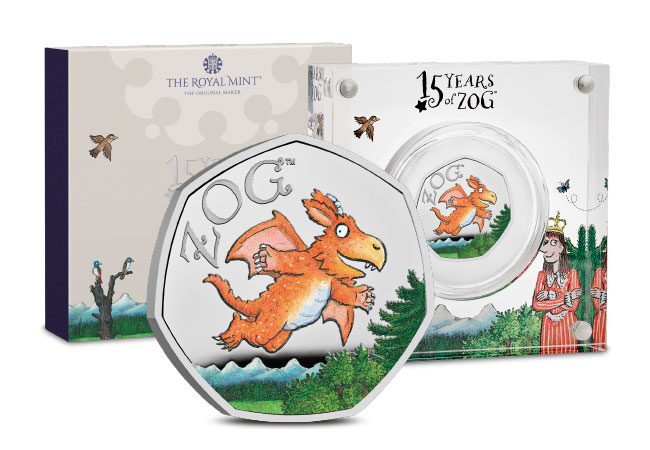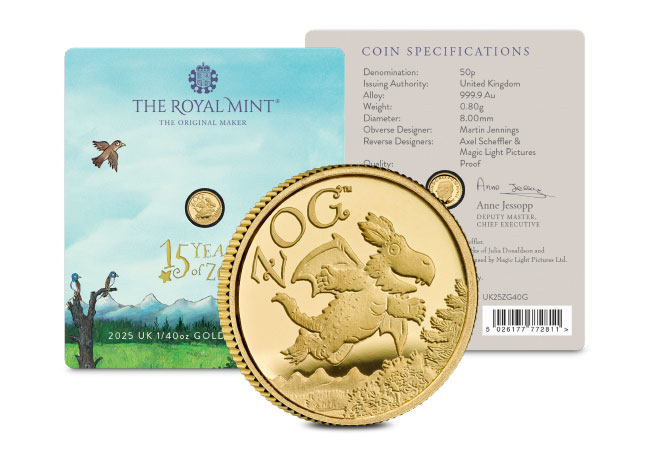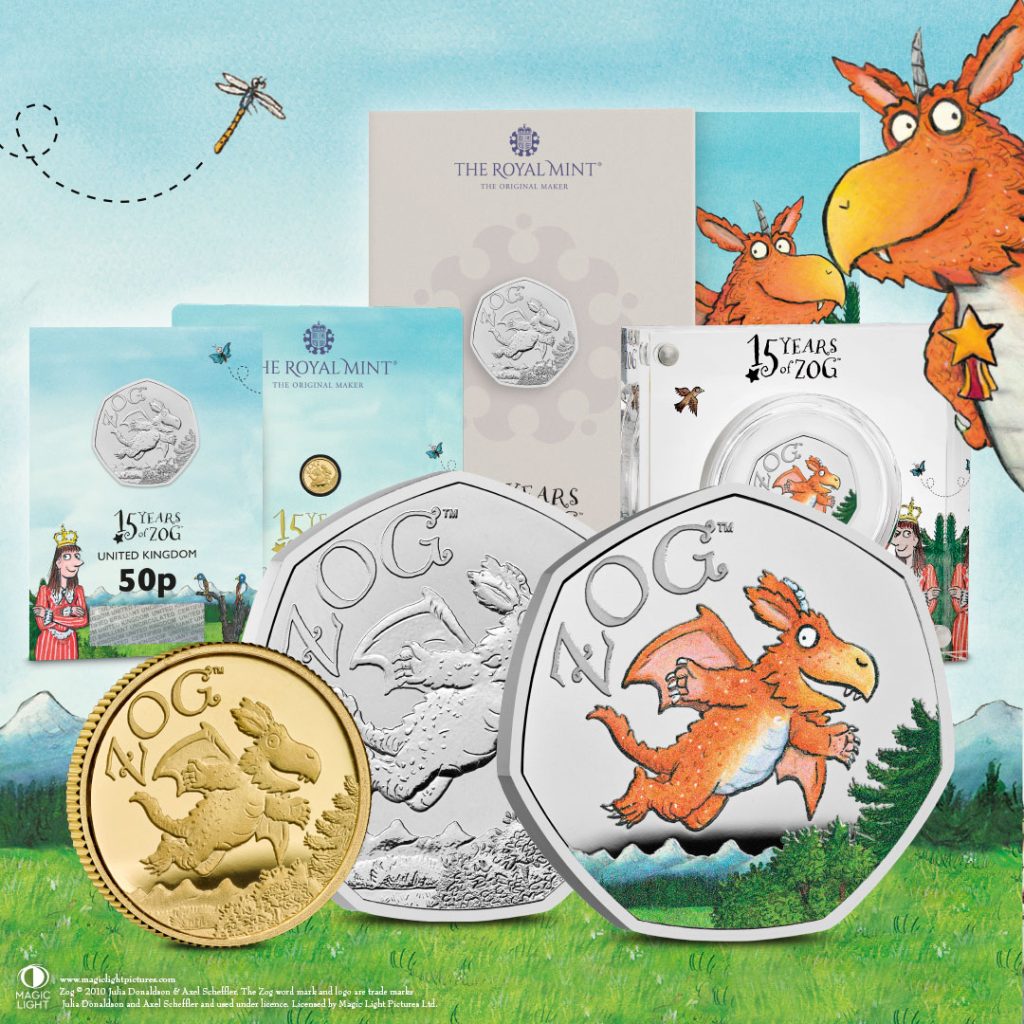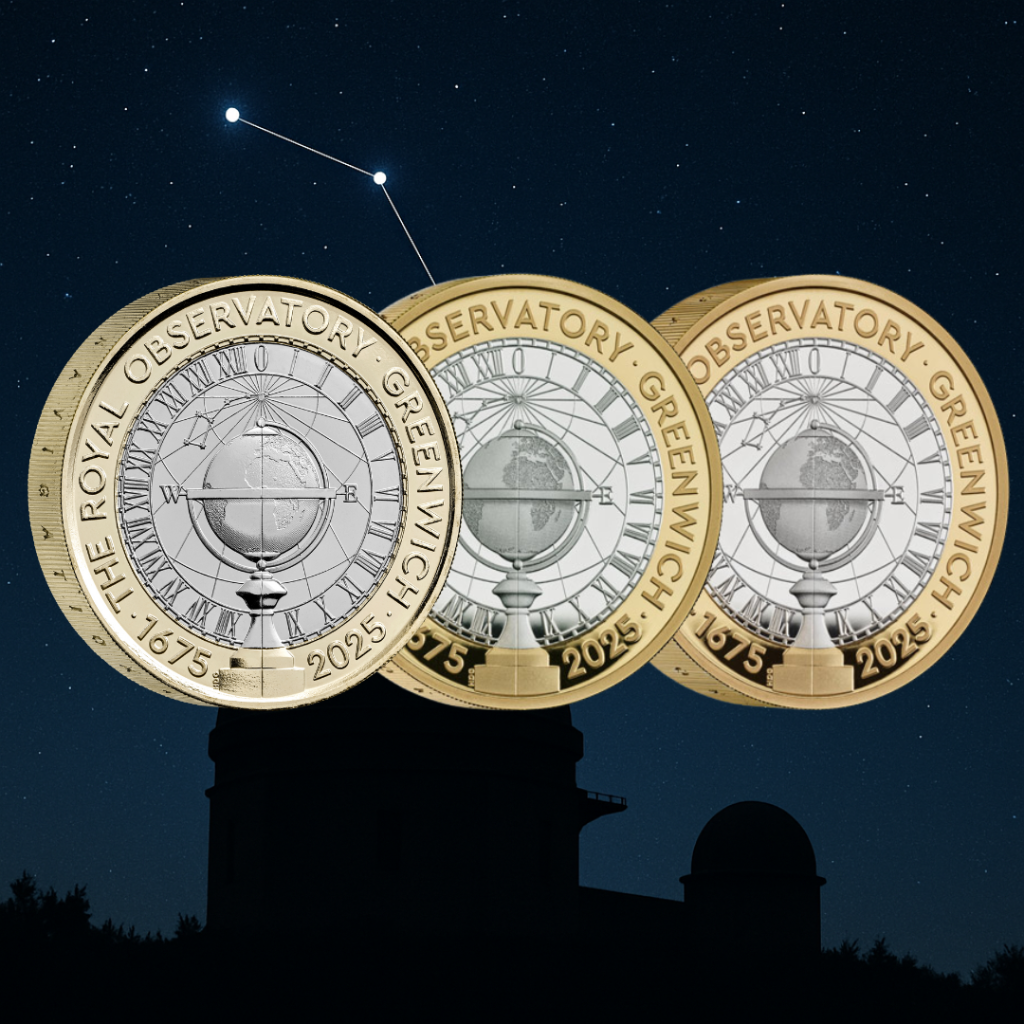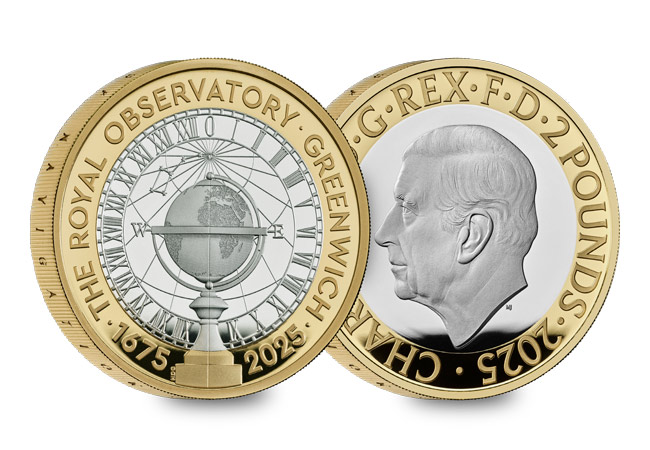Blog Home
Could the 2025 UK Zog 50p be RARER than the sell-out Gruffalo 50p?
For the very first time, the loveable, accident-prone dragon Zog has been celebrated on a UK 50p coin, marking 15 magical years since the much-loved children’s book was first published.
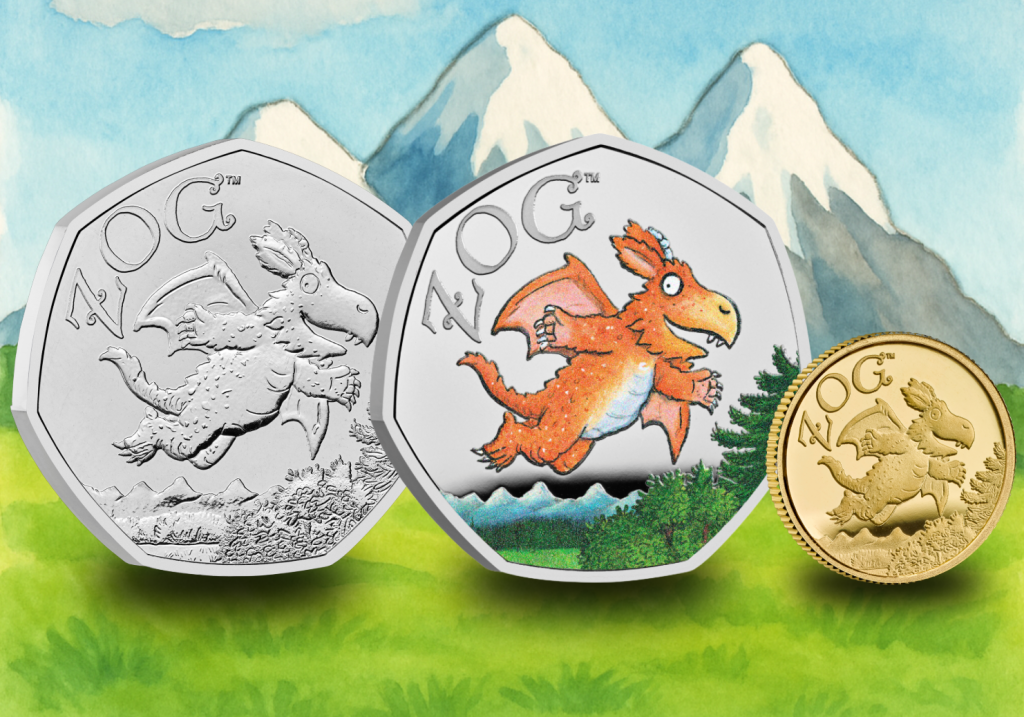
Explore the 2025 UK Zog 50p Range >>
Zog turns 15
Since Zog first burst onto the scene in 2010, he’s captured imaginations around the world. Written by Julia Donaldson, former UK Children’s Laureate, and brought to life with Axel Scheffler’s iconic illustrations, the tale of perseverance, friendship (and a few fiery mishaps!) has become a bedtime favourite.
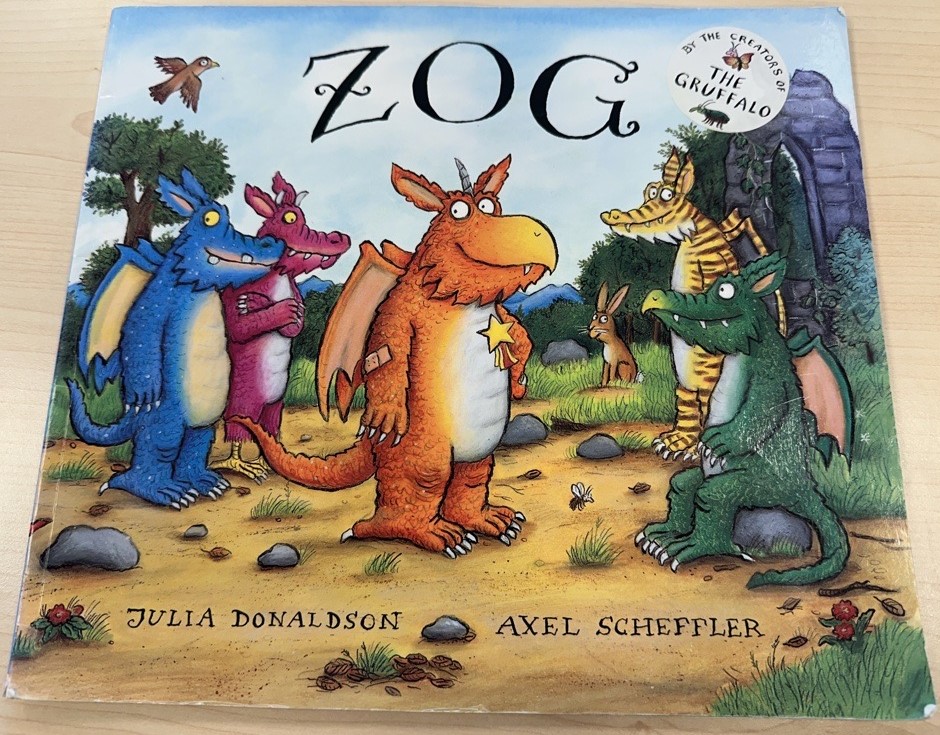
Over 4.5 million copies of Zog have been sold globally, and its timeless charm continues to delight both children and adults.
The FIRST ever Zog coin
To mark 15 year of the much loved story, Zog is taking centre stage on a UK 50p for the very first time.
The coin’s reverse has been beautifully designed by Emma Noble, who has expertly captured the moment Zog learns to fly, taking inspiration straight from the pages of the beloved story.
Now here’s where it gets really exciting, and why you’ll need need to act fast if you want to get your hands on one…
Tiny edition limits
Two of the most sought-after versions of the Zog 50p have been issued with incredibly small edition limits, making it even rarer than the sell-out 2019 Gruffalo 50p!
Just 3,500 Silver Proof Zog 50ps are available and the Gold Proof 1/40oz has an edition limit of just 1,000.
The 2019 Gruffalo 50p, 2019 Gruffalo and Mouse 50p and the 2024 Gruffalo’s Child 50p all had Silver Proof edition limits of 25,000, and all sold out within just hours of release! So to put this into perspective, the Zog Silver Proof 50p has an edition limit SEVEN TIMES smaller that previous sell-out Julia Donaldson coins!
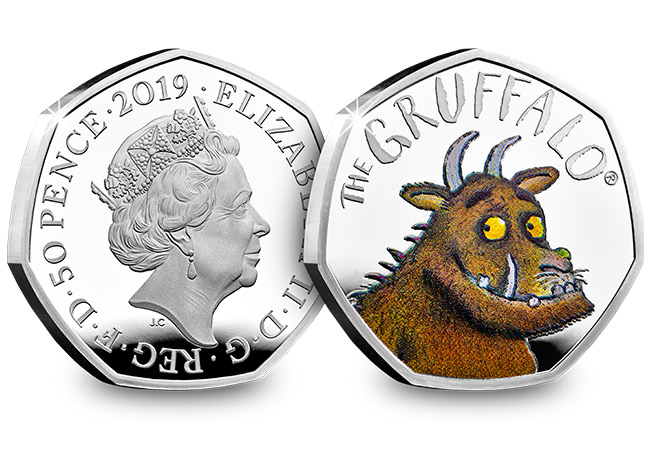
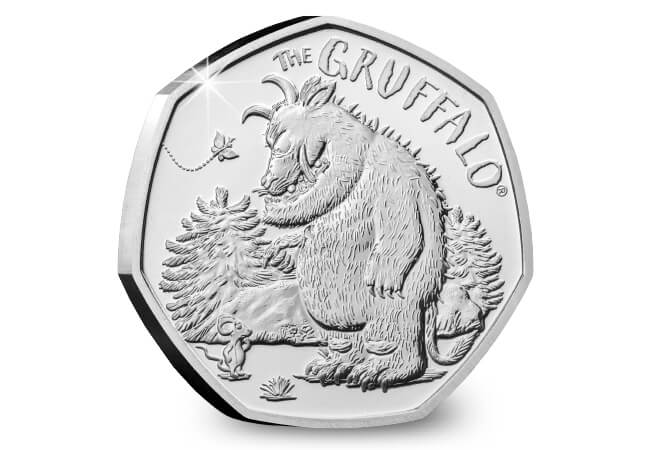

And the Gold Proof 1/40oz? Well, with just 1,000 available, it’s one of the most limited gold 50p releases we’ve ever seen.
Don’t miss out on securing your Zog 50p
With such tiny edition limits, and the huge popularity of Julia Donaldson’s coins, don’t miss out on your chance to secure your Zog 50p.
350 Years of the Royal Observatory, Greenwich celebrated on a UK £2 coin
Originally released as part of the 2025 Annual Coin Set, the 2025 UK Royal Greenwich Observatory £2 is now available to own individually for the very first time – and it’s bursting with history and symbolism.
Explore the UK Royal Observatory, Greenwich £2 Coin Range >>
Celebrating 350 Years of Innovation and Exploration
In 1675, King Charles II commissioned the Royal Observatory at Greenwich, unknowingly setting in motion centuries of astronomical discovery, navigational breakthroughs and global timekeeping.

Image Credit: DiscoA340, via Wikimedia Commons
Greenwich is where East meets West, and home to the Prime Meridian – an invisible line that runs through the very ground. The Royal Observatory is where Greenwich Mean Time was born, and it’s been guiding explorers, scientists and seafarers ever since.
Now, 350 years on, this iconic institution has been honoured on a UK £2 coin.
A Design Packed with Symbolism
Created by renowned designer Henry Gray, the reverse design of the 2025 Royal Greenwich Observatory £2 is a treasure trove for collectors.
Here’s what you’ll spot:
- The Shepherd Gate Clock – one of the world’s first public displays of Greenwich Mean Time.
- Ursa Minor and Polaris – the constellation and star used for celestial navigation across centuries.
- The Prime Meridian on a globe – marking the division between East and West.
- And along the edge, the words: “PERFECTING THE ART OF NAVIGATION” – a phrase taken from the Observatory’s founding Royal Warrant.
Every detail speaks to the Observatory’s unmatched contribution to science, timekeeping, and navigation.
Watch our video
Deserving of a space in your collection
You can secure the 2025 UK Royal Observatory £2 in Brilliant Uncirculated quality, or for something truly special, it’s also available in Silver Proof and Silver Piedfort.
The Silver Proof version has an edition limit of 1,500, and just 650 of the Silver Piedfort coins are available. Demand for these coins is expected to be high, so don’t hesitate as you may miss out on securing yours!
The Coins That Nearly Didn’t Exist: The Unique Story Behind the Tutankhamun Treasures 50p Set
In 1922, the world was captivated by the discovery of Tutankhamun’s Tomb – a treasure trove of ancient Egyptian artefacts buried beneath the sands of time.
Over 100 years later, that moment has been honoured with a remarkable set of 50p coins – The Tutankhamun Treasures BU 50p Collection.
Approved by TWO monarchs and featuring THREE distinct dates, these coins carry a story as compelling as the artefacts they commemorate…
Watch our latest video below to discover the story behind the Tutankhamun Treasures BU 50p Set.
Approved by TWO monarchs
Originally approved by Queen Elizabeth II in 2022, the Tutankhamun Treasures 50p Coins were among the very last coins to receive her approval before her sad passing in September 2022.
But the change in monarchy put everything on pause. To proceed, the coins needed to be resubmitted to Buckingham Palace and King Charles III.
And in early 2023, the coins were officially reauthorised for release by King Charles III – now bearing His Majesty’s effigy by Glyn Davies, these were the FIRST 50p coins ever issued with this portrait.
Featuring THREE distinct dates
The unusual journey that these coins took to be released has created a truly rare collecting quirk – each coin features three different years!
- 1922 – Marking the discovery of Tutankhamun’s Tomb
- 2022 – When Queen Elizabeth II first approved the coins
- 2023 – When King Charles III re-authorised the coins for release
Triple-dated coins are exceptionally uncommon in numismatic history. In fact, the most comparable example was the Team GB 50p issued after the delayed 2020 Olympics – and that became one of the most sought-after coins of its year.
Time is running out…
We’re now down to our last remaining stocks of the Tutankhamun Treasures 50p Set, which means it won’t be long until these coins are lost to the sands of time…
Each coin in the collection has been struck to a Brilliant Uncirculated finish and features an ancient artefact that was discovered in Tutankhamun’s Tomb – including his iconic Death Mask, the Anubis Shrine, a Pendant, a Corselet and a model of the young pharaoh’s torso.


